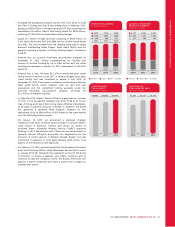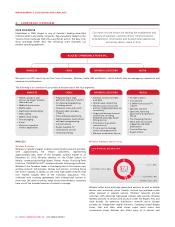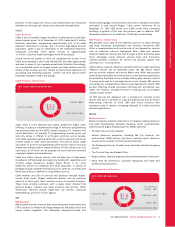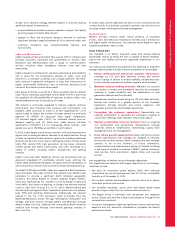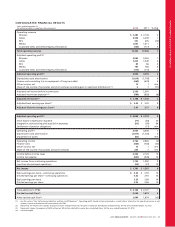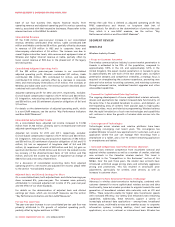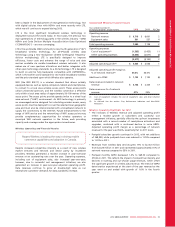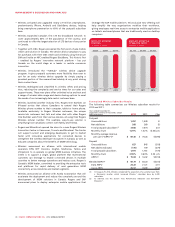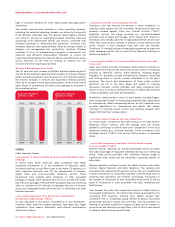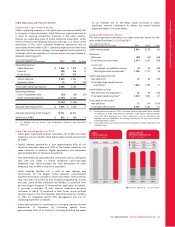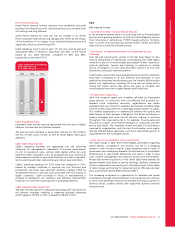Rogers 2012 Annual Report Download - page 39
Download and view the complete annual report
Please find page 39 of the 2012 Rogers annual report below. You can navigate through the pages in the report by either clicking on the pages listed below, or by using the keyword search tool below to find specific information within the annual report.
MANAGEMENT’S DISCUSSION AND ANALYSIS
been a leader in the deployment of next generation technology, first
with digital cellular, then with HSPA+ and more recently with LTE,
which we will continue to expand during 2013.
LTE is the most significant broadband wireless technology in
deployment around the world today. In most cases, the previous two
main generations of technology paths in the wireless industry – GSM/
HSPA+ and Code Division Multiple Access/Evolution Data Optimized
(“CDMA/EVDO”) – are now converging.
LTE is the worldwide GSM community’s new fourth generation (“4G”)
broadband wireless technology. An all-IP-based wireless data
technology using a new modulation scheme (orthogonal frequency-
division multiplexing), LTE is specifically designed to improve
efficiency, lower costs and enhance the range of voice and data
services available via mobile broadband wireless networks. It also
makes use of new spectrum allocations and better integrates with
other open technology standards. As a 4G technology, LTE is designed
to build on and be fully backwards compatible with UMTS/HSPA+,
which is the earlier world standard for 3G mobile broadband wireless
and the prior standard upon which Wireless also operates.
WiFi (the IEEE 802.11) is a wireless standard that allows suitably
equipped devices, such as laptop computers, tablets and smartphones,
to connect to a local area wireless access point. These access points
utilize unlicenced spectrum, and the wireless connection is effective
only within a local area radius of approximately 50–100 metres of the
access point. The access points provide speeds similar to a wired local
area network (“LAN”) environment. As WiFi technology is primarily
an unmanaged service designed for in-building wireless access, many
access points must be deployed to cover the selected local geographic
area and must also be interconnected with a broadband network to
supply the connectivity to the Internet. Future enhancements to the
range of WiFi service and the networking of WiFi access points may
provide complementary opportunities for wireless operators or
municipal WiFi network operators in the future, each providing
capacity and coverage under the appropriate circumstances.
Wireless Operating and Financial Results
Rogers Wireless is leading the way in driving mobile
commerce capabilities and adoption in Canada.
Despite increased competitive intensity as a result of new wireless
market entrants and network and device parity by incumbent
providers, Wireless generated a modest increase in year-over-year
revenue at an accelerating rate over the year. Operating expenses,
including cost of equipment sales, also increased year-over-year;
however, due to successful cost management initiatives, we also
generated an increase in year-over-year adjusted operating profit.
Data revenues continue to grow at double-digit rates as our
smartphone customers’ demands for data availability increase.
Summarized Wireless Financial Results
Years ended December 31,
(In millions of dollars, except margin) 2012 2011 % Chg
Operating revenue
Network revenue $ 6,719 $ 6,601 2
Equipment sales 561 537 4
Total operating revenue 7,280 7,138 2
Operating expenses
Cost of equipment(1) (1,585) (1,425) 11
Other operating expenses (2,632) (2,677) (2)
(4,217) (4,102) 3
Adjusted operating profit(2) $ 3,063 $ 3,036 1
Adjusted operating profit margin as
% of network revenue(2) 45.6% 46.0%
Additions to PP&E $ 1,123 $ 1,192 (6)
Data revenue included in network
revenue $ 2,722 $ 2,325 17
Data revenue as % of network
revenue 41% 35%
(1) Cost of equipment includes the cost of equipment sales and direct channel
subsidies.
(2) As defined. See the section “Key Performance Indicators and Non-GAAP
Measures”.
Wireless Operating Highlights for 2012
• The increases in Wireless revenue and adjusted operating profit
reflect a modest growth in subscribers and successful cost
management initiatives, partially offset by the upfront investments
associated with a record number of smartphone activations and
upgrades, combined with a continued decline in voice ARPU.
Adjusted operating profit margin as a percentage of network
revenue for the year was 45.6%, essentially flat to 2011 levels.
• Postpaid subscriber growth continued in 2012, with net additions
of 268,000, while postpaid churn was reduced to 1.29% compared
to 1.32% in 2011.
• Revenues from wireless data services grew 17% to $2,722 million
from $2,325 million in 2011 and represented approximately 41% of
network revenue compared to 35% in 2011.
• Postpaid monthly ARPU decreased 1.4% to $69.30 compared to
$70.26 in 2011. This reflects the impact of competitive intensity and
declines in roaming and out-of-plan usage revenues, which offset
the significant growth in wireless data revenue. The trend of ARPU
deterioration experienced at the start of the year reversed as the
year went on and ended with growth of 1.6% in the fourth
quarter.
2012 ANNUAL REPORT ROGERS COMMUNICATIONS INC. 35


